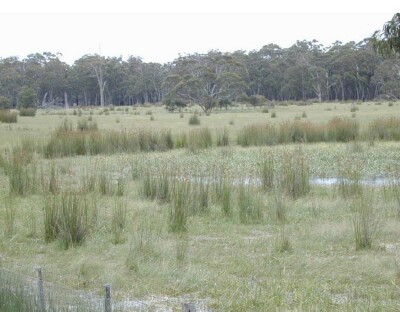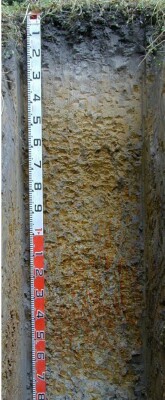GHF03b
Location: Bessiebelle
Australian Soil Classification: Bleached-Ferric, Mesotrophic, Brown KUROSOL (thick sandy surface horizons)
General Landscape Description: Gently undulating Plain
Site Description: Plain
Land Unit: Follet Dunes and Plains
Geology: Quaternary aeolian
General Land Unit Description: The majority of this land unit falls south of the Kanawinka fault. This land unit comprises areas with deep sand deposits. The residual landscape is thought to be influenced by the retreat of the Murray Sea which left stranded beach ridges oriented south west–north east. These were subsequently covered by superficial sand sheets in later depositional phases, which formed the landscape we see today.
The major landforms in this land unit are dunes and swales. Podosols and Kurosols or Chromosols are the major soil types found on the dunes and rises. Podosols are soils with a ‘coffee rock’ layer (refer to photograph below). The Kurosols or Chromosols tend to have a deep sandy topsoil over the clay. The common soil types on the swales are black cracking clay (Vertosols) or Grey Sodosols. Some Ferric Kurosols or Chromosols can also occur on the swales or lower slopes of the dunes.

Soil Profile Morphology
Surface
| A1 | 0-15 cm | Very dark grey (10YR3/1) sandy loam; single grain structure; loose consistence when dry; many medium roots; clear and smooth transition to: |  |
| A2 | 15-30 cm | Greyish brown (10YR5/2) loamy sand; single grain structure; very weak consistence when dry; many medium roots; clear and smooth transition to: | |
| A3 | 30-50 cm | Light yellowish brown (10YR6/5) clayey sand; massive structure; weak consistence when dry; many medium ferruginous nodules; many very fine macropores; aereal porosity 0.5%; few fine roots; abrupt and smooth transition to: | |
| Subsoil | |||
| B21 | 50-90 cm | Yellowish brown (10YR5/6), light medium clay; weak polyhedral structure (20-50 mm) parting to moderate polyhedral structure (10-20 mm); firm consistence when moderately moist; common very fine macropores; areal porosity 0.1%; few very fine roots; diffuse and smooth transition to: | |
| B22 | 90-150 cm | Light yellowish brown (10YR6/4) with many medium distinct brownish yellow (10YR6/8) and yellowish red (5YR5/8) mottles, light medium clay; moderate polyhedral structure (20-50 mm) parting to strong polyhedral structure (5-10 mm); weak consistence when moderately moist; few very fine macropores; areal porosity 0.03%; few very fine roots; gradual and smooth transition to: | |
| B3 | 150-180 cm | Light grey (10YR7/1) with many coarse prominent brownish yellow (10YR6/8) and red (2.5YR4/8) mottles, heavy clay; weak polyhedral structure (20-50 mm); firm consistence when moist; very few medium ferruginous nodules; few very fine macropores; areal porosity 0.01%; few very fine roots. | |
| 180-380 cm | Grey medium to heavy (clays as in plot 4), with pockets of red brown sandy clay, live and remnant roots to 380 cm along clay ped faces and in old root channels, slickensides and some limestone present. | ||
Notes: There was sig
nificant variation in the abundance of segregations (nodules) observed in the third layer (A3) in the face and side of the soil pit.Soil Profile Characteristics:
- | pH | Salinity | ||
Surface Soil (A1 horizon) | Strongly Acid | Very Low | Non-Sodic | None |
Subsoil (B21 Horizon) | Strongly Acid | Very Low | Non-Sodic | None |
Deeper Subsoil (150-180 cm) | Moderately Acid | Low | - | None |
Chemical and Physical Analysis:
Horizon | Horizon Depth (cm) | pH (water) | pH (CaCl2) | EC dS/m | Organic Carbon % | Total Nitrogen % | Exchangeable Aluminium ppm | Exchangeable Acididty meq/100g | Exchangeable Cations | Coarse Sand (0.2-2.0 mm) % | Fine Sand (0.02-0.2 mm) % | Silt (0.002-0.02 mm) % | Clay (<0.002 mm) % | Field Capacity % w/w | Wilting Point % w/w | |||
Ca | Mg | K | Na | |||||||||||||||
meq/100g | ||||||||||||||||||
A1 | 0-15 | 5.3 | 4.6 | <0.05 | 3.0 | 0.13 | 19 | 3.3 | 0.85 | 0.09 | 0.06 | 44 | 36 | 12 | 5 | 18.1 | 4.9 | |
A2 | 15-30 | 5.3 | 4.5 | <0.05 | 14 | 0.87 | 0.41 | <0.05 | <0.05 | 46 | 39 | 8 | 5 | 10.3 | 24.9 | |||
A3 | 30-50 | 5.4 | 4.6 | <0.05 | 35 | 0.65 | 0.54 | <0.05 | <0.05 | 49 | 34 | 7 | 9 | 10.6 | 23.0 | |||
B21 | 50-90 | 5.4 | 4.8 | 0.10 | 10 | 32 | 3.0 | 4.6 | 0.11 | 0.74 | 15 | 7 | 3 | 75 | 39.1 | 25.7 | ||
B22 | 90-150 | 5.5 | 5.3 | 0.18 | 9.2 | <10 | 3.8 | 4.2 | 0.08 | 1.1 | 12 | 7 | 8 | 73 | 38.4 | 25.4 | ||
B3 | 150-180 | 6.0 | 5.7 | 0.21 | <10 | |||||||||||||
Profile Described By: Ian Sargeant and Paul Feikema (December 2000)


